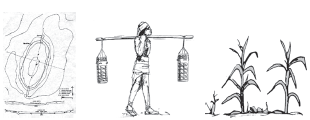 |
Characteristics of Fertilizer dehydration basin-Paquimé Slot Catchment, Hohokam Oval Dish Catchment, Anasazi Masonry Mulching Ponds 1. Topographically centralized depressions behind one or two oval or circular dams of masonry or earth. 2. Designed and function to collect rainwater from a relatively limited area or catchment. 3. Hold water for a short period of time, especially associated with monsoonal weather patterns. 4. Stratigraphy demonstrates a distinct layer of organic material above a floor sealed with plaster, adobe mud, or caliche. 5. Often associated with shards of water transport vessels of high quality and design features . 6. Located near towns or habitations which have a more proximate water supply of higher quality and/or quantity. 7. Also found in predominantly agricultural resource areas not closely/directly associated with known towns or habitations. 8. Two Sinagua sites, Wupatki and Winona Village, share characteristics with the Anasazi site of Mummy Lake, Mesa Verde, in that they have two masonry walls on the perimeter of the “ballcourt” which are filled, at least in part, with sediment taken from the “dish shaped” plastered floor. At Woods Canyon Reservoir, Richard A Wilshusen notes there was extensive “clearing of this sediment and placement on top of the dam ... must represent an ongoing process, otherwise the catchment basin would have filled only with sediment ... the soil in the immediate area is of sufficient quality to germinate corn or beans .... vessel forms combined with the high percentage of white ware are quite appropriate for dipping water, transporting water a short distance, or excavating muddy sediments from the basin ... it is of course possible that the basin was used for agricultural purposes ... over 77% of all the sherds are white wares, and the predominant form is jars ... this is a very different assemblage than any other site in our experience ... finally, the extremely high percentage of white ware jars and relative paucity of gray ware suggests a special-use site rather than a habitation site ... [at] Mummy Lake excavations, 86% are jar forms and 87% are white wares ... [Ponding] features such as Woods Canyon Reservoir, Little Cajon Lake, Goodman Lake, and Moqui Lake are not physically a part of a large site, although large potential Chaco-era communities are usually within 2 km....” Wilshusen, Churchill, Potter |
|||||
|
||||||
 |
||||||
 |
||||||
copyright 2005 - Richard D Fisher - DigitalTeamWorks.com
